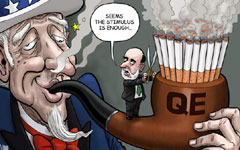The rise of realism in emerging Asia
By David Mann (China Daily) Updated: 2014-02-18 07:49Now that the super-easy monetary policy, dubbed "quantitative easing" (QE), is coming to an end in the United States, some say this is also the end of the emerging markets' growth story. We at Standard Chartered disagree. In fact, the ending of QE ending bodes well for the emerging markets, especially those in Asia, the region most open to trade.
|
 |
|
 |
For the first time in years, all major economies are set to grow at a reasonable rate. The world economy is at long last gaining a more solid footing, with multiple drivers of growth.
This is good news for growth in emerging Asian economies, which have increasingly used leverage to support domestic demand in the post-crisis years. While leverage has become stretched in pockets of some economies, there is little reason to expect this - external events in 2014 - to lead to a crisis.
The region is not in a bubble, and there is no "miracle economy" anywhere. A new, more realistic and balanced view of Asia is emerging among global investors - one in which local markets do not outperform year after year, regardless of the risks, and one where prices can adjust downward when excessive optimism has crept in.
Many commentators are worried about the impact of higher global interest rates and tighter financial conditions on emerging markets, which have hitherto benefited from large inflows and easy financing conditions (since 2009, emerging Asia has seen gross inflows of about $630 billion).
The sell-off we saw in emerging markets last year - when investors were anticipating QE tapering - were just the beginning, these commentators argue.
- NHTSA says finds no 'defect trend' in Tesla Model S sedans
- WTO rare earth ruling is unfair
- Amway says 2014 China sales may grow 8%
- President Xi in Europe: Forging deals, boosting business
- CNOOC releases 2013 sustainability report
- Local production by Chery Jaguar Land Rover this year
- Car lovers test their need for speed in BMW Mission 3
- China stocks close mixed Monday

















